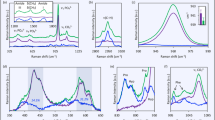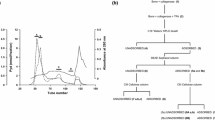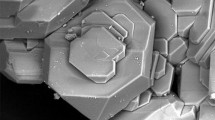Abstract
We studied the structure of the mammoth tusk by infrared spectroscopy, including after heat treatment. The entire complex of functional groups of the tusk components—hydroxyapatite, collagen, and water—was revealed. Collagen is represented in the IR spectrum by the characteristic absorption bands of amide and aliphatic groups. After heat treatment at 600°C, the organic part is completely removed from the sample. Hydroxyapatite occurs in the tusk bone tissues in a carbonate-substituted form; the heat treatment at 900°C removes the carbonate anion and water from the sample, transiting hydroxyapatite from a nonstoichiometric state to a stoichiometric one.



Similar content being viewed by others
REFERENCES
K. Janssens, L. Vincze, B. Vekemans, C. T. Williams, M. Radtke, M. Haller, and A. Knochel, Fresenius J. Anal. Chem. 363, 413 (1999). https://doi.org/10.1007/s002160051212
K. M. Lee, J. Appleton, M. Cooke, K. Sawiska-Kapusta, and M. Damer, Fresenius J. Anal. Chem. 364, 245 (1999). https://doi.org/10.1007/s002160051331
Y. Fernandez-Jalvo and M. D. M. Monfort, Geobios 41, 157 (2008). https://doi.org/10.1016/j.geobios.2006.06.006
I. Revenko, F. Sommer, D. T. Minh, and R. Garrone, J. Franc. Biol. Cell 80, 67 (1994). https://doi.org/10.1016/0248-4900(94)90019-1
V. I. Nikolaev, M. Barbieri, S. Davanzo, T. V. Kuznetsova, A. Lonzhinelli, L. D. Sulerzhitskii, and P. Yakumin, in Quarter-2005, Proceedings of the IV All-Russia Meetings on the Study of the Quaternary Period, Ed. by N. P. Yushkin (Geoprint, Syktyvkar, 2005), p. 297.
M. L. Zorina, A. B. Kol’tsov, O. V. Frank-Kamenetskaya, and O. V. Ozarovskaya, Istor. Geol. Evol. Geogr., No. 4, 51 (2004).
O. V. Ozarovskaya and M. L. Zorina, Zap. Ross. Mineral. Ob-va 137 (5), 73 (2008).
L. Wang, H. Fan, J. Liu, H. Dan, Q. Ye, and M. Deng, Mineral. Mag. 71, 509 (2007). https://doi.org/10.1180/minmag.2007.071.5.509
H. Edwards, S. Jorge-Villar, F. Nik, A. Nlin, S. O’Connor, and D. Charlton, Anal. Bioanal. Chem. 383, 713 (2005). https://doi.org/10.1007/s00216-005-0011-z
L. E. Cartier, M. S. Krzemnicki, M. Gysi, B. Lendvay, and N. V. Morf, J. Gemmol. 37, 282 (2020). https://doi.org/10.15506/JoG.2020.37.3.282
M. Ch. Chang and J. Tanaka, Biomaterials 23, 4811 (2002). https://doi.org/10.1016/S0142-9612(02)00232-6
C. Chappard, G. Andre, M. Daudon, and D. Barin, C. R. Chim. 19, 1625 (2016). https://doi.org/10.1016/j.crci.2015.03.015
A. Grunenwald, C. Keyser, A. M. Sautereau, E. Crubery, B. Ludes, and C. Drouet, J. Archaeol. Sci. 49, 134 (2014). https://doi.org/10.1016/j.jas.2014.05.004
K. Haberko, M. Bucko, J. Brzezinska-Miecznik, M. Haberko, W. Mozgawa, T. Panz, A. Pyda, and J. Zarebski, J. Eur. Ceram. Soc. 26, 537 (2006). https://doi.org/10.1016/j.jeurceramsoc.2005.07.033
T. Sakae, H. Oinuma, M. Higa, and Y. Kozawa, J. Oral Biosci. 47, 83 (2005). https://doi.org/10.1016/S1349-0079(05)80013-1
V. M. Zolotarev and G. A. Khlopachev, Opt. Spectrosc. 114, 946 (2013). https://doi.org/10.1134/S0030400X13040231
S. L. Votyakov, D. V. Kiseleva, Yu. V. Shchapova, N. G. Smirnov, and N. O. Sadykova, Physico-Chemical Characteristics of Fossil Bone Remains of Mammals and the Problem of Assessing their Relative Age. Part 1. Thermal and Mass Spectrometric Elemental Analysis (Goshitskii, Ekaterinburg, 2009) [in Russian].
S. L. Votyakov, D. V. Kiseleva, Yu. V. Shchapova, N. G. Smirnov, and N. O. Sadykova, Physico-Chemical Characteristics of Fossil Bone Remains of Mammals and the Problem of Assessing their Relative Age. Part 2. IR and Radio Spectroscopy, Microscopy (Goshitskii, Ekaterinburg, 2009) [in Russian].
V. M. Zolotarev, Opt. Spectrosc. 116, 599 (2014). https://doi.org/10.1134/S0030400X14040286
V. I. Silaev, D. V. Ponomarev, Yu. S. Simakova, S. N. Shanina, I. V. Smoleva, E. M. Tropnikov, and A. F. Khazov, Vestn. Inst. Geol. Komi NTs UrO RAN 257 (5), 19 (2016). https://doi.org/10.19110/2221-1381-2016-5-19-31
M. J. Glimcher, Rev. Miner. Geochem. 64, 223 (2006). https://doi.org/10.2138/rmg.2006.64.8
T. M. Solovev, E. S. Petukhova, G. V. Botvin, T. A. Isakova, and V. V. Pavlova, IOP Conf. Ser.: Mater. Sci. Eng. 1079, 042011 (2021). https://doi.org/10.1088/1757-899X/1079/4/042011
S. N. Danil’chenko, Visn. SumDu, Ser. Fiz., Mat., Mekh., No. 2, 33 (2007).
R. G. Knubovets and L. D. Kislovskii, in Physics of Apatite, Collection of Articles, Ed. by V. S. Sobolev (Nauka, Novosibirsk, 1975) [in Russian].
A. B. Brik, O. V. Frank-Kamenetskaya, V. A. Dubok, E. A. Kalinichenko, M. A. Kuz’mina, M. L. Zorina, N. A. Dudchenko, A. M. Kalinichenko, and N. N. Bagmut, Mineral. Zh. 35 (3), 3 (2013).
L. G. Gilinskaya, T. N. Grigor’eva, Yu. N. Zanin, T. A. Korneva, and V. N. Stolpovskaya, Geochem. Int. 39, 244 (2001).
T. M. de Batista, V. C. A. Martins, and A. M. de Guzzi Plepis, J. Therm. Anal. Calorim. 95, 945 (2009). https://doi.org/10.1007/s10973-007-8897-7
A. Onishi, P. S. Thomas, B. H. Stuart, et al., J. Therm. Anal. Calorim. 88 (2), 405 (2007). https://doi.org/10.1007/s10973-006-8135-8
J. Shi, A. Klocke, M. Zhang, and U. Bismayer, Eur. J. Miner. 17, 769 (2005). https://doi.org/10.1127/0935-1221/2005/0017-0769
G. A. Khlopachev and E. Yu. Girya, Secrets of Ancient Bone Carvers of Eastern Europe and Siberia: Mammoth Tusk and Reindeer Horn Processing Techniques in the Stone Age (According to Archaeological and Experimental Data) (Nauka, St. Petersburg, 2010) [in Russian].
Funding
The work was supported within the framework of the state order no. AAAA-A20-120011490003-9.
Author information
Authors and Affiliations
Corresponding author
Ethics declarations
The authors declare that they have no conflicts of interest.
Additional information
Translated by O. Zhukova
Rights and permissions
About this article
Cite this article
Pavlova, V.V., Petukhova, E.S., Isakova, T.A. et al. Study of the Structure of Mammoth Tusk by IR Spectroscopy. Opt. Spectrosc. 130, 207–213 (2022). https://doi.org/10.1134/S0030400X22030110
Received:
Revised:
Accepted:
Published:
Issue Date:
DOI: https://doi.org/10.1134/S0030400X22030110




